SIM 335 Project Management: Tasks 1 & 2 - Hybrid System for LSC
VerifiedAdded on 2023/03/23
|20
|4113
|88
Project
AI Summary
This assignment presents a comprehensive project management plan for a hybrid system intended for London Skills Concern (LSC). The plan covers the project's goals, objectives, and the chosen Project Management Body of Knowledge (PMBoK) methodology, outlining the five key phases: initiation, planning, execution, control, and closure. The initiation phase includes analysis of existing LSC operations and the identification of gaps, while the planning stage details scope, schedule, resource allocation, risk management, and stakeholder analysis. The execution phase focuses on the development and integration of project modules, including social media integration and online game-based learning. The control phase involves integration, implementation cycles, and quality audits. The document includes detailed Work Breakdown Structures (WBS), Gantt charts, network diagrams, and risk management strategies. The plan also incorporates an executive summary, project background, and methodology, providing a complete overview of the project's lifecycle. Furthermore, the assignment includes answers to project management questions related to key characteristics of projects, project stages, the purpose of Project Initiation Documents, knowledge areas, project manager responsibilities, and stakeholder analysis.

qwertyuiopasdfghjklzxcvbnmqw
ertyuiopasdfghjklzxcvbnmqwert
yuiopasdfghjklzxcvbnmqwertyui
opasdfghjklzxcvbnmqwertyuiop
asdfghjklzxcvbnmqwertyuiopasd
fghjklzxcvbnmqwertyuiopasdfgh
jklzxcvbnmqwertyuiopasdfghjkl
zxcvbnmqwertyuiopasdfghjklzxc
vbnmqwertyuiopasdfghjklzxcvb
nmqwertyuiopasdfghjklzxcvbnm
qwertyuiopasdfghjklzxcvbnmqw
ertyuiopasdfghjklzxcvbnmqwert
yuiopasdfghjklzxcvbnmqwertyui
opasdfghjklzxcvbnmqwertyuiop
asdfghjklzxcvbnmqwertyuiopasd
fghjklzxcvbnmqwertyuiopasdfgh
jklzxcvbnmrtyuiopasdfghjklzxcv
Project Management
Task 1 & 2
5/31/2019
ertyuiopasdfghjklzxcvbnmqwert
yuiopasdfghjklzxcvbnmqwertyui
opasdfghjklzxcvbnmqwertyuiop
asdfghjklzxcvbnmqwertyuiopasd
fghjklzxcvbnmqwertyuiopasdfgh
jklzxcvbnmqwertyuiopasdfghjkl
zxcvbnmqwertyuiopasdfghjklzxc
vbnmqwertyuiopasdfghjklzxcvb
nmqwertyuiopasdfghjklzxcvbnm
qwertyuiopasdfghjklzxcvbnmqw
ertyuiopasdfghjklzxcvbnmqwert
yuiopasdfghjklzxcvbnmqwertyui
opasdfghjklzxcvbnmqwertyuiop
asdfghjklzxcvbnmqwertyuiopasd
fghjklzxcvbnmqwertyuiopasdfgh
jklzxcvbnmrtyuiopasdfghjklzxcv
Project Management
Task 1 & 2
5/31/2019
Paraphrase This Document
Need a fresh take? Get an instant paraphrase of this document with our AI Paraphraser
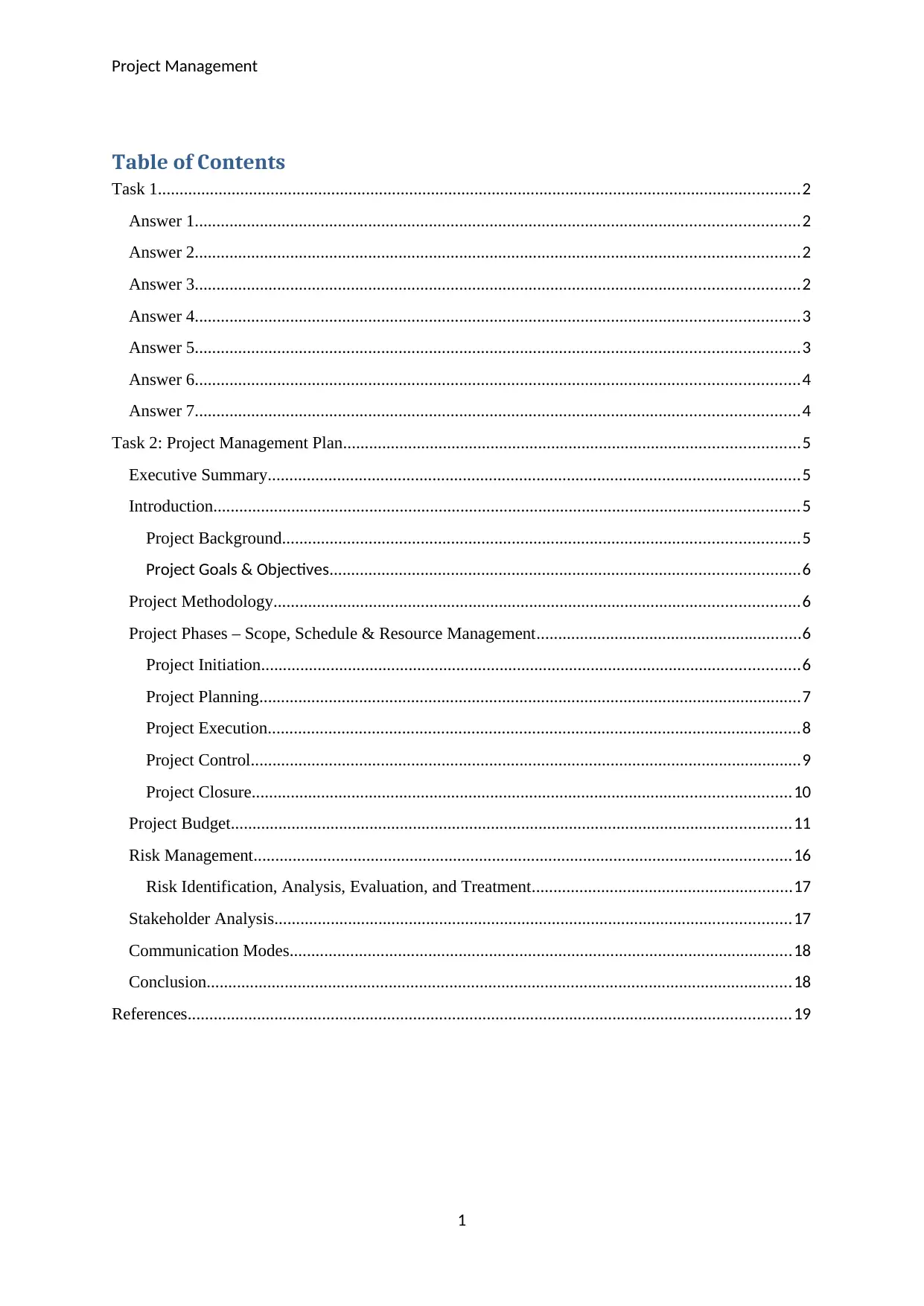
Project Management
Table of Contents
Task 1....................................................................................................................................................2
Answer 1...........................................................................................................................................2
Answer 2...........................................................................................................................................2
Answer 3...........................................................................................................................................2
Answer 4...........................................................................................................................................3
Answer 5...........................................................................................................................................3
Answer 6...........................................................................................................................................4
Answer 7...........................................................................................................................................4
Task 2: Project Management Plan.........................................................................................................5
Executive Summary...........................................................................................................................5
Introduction.......................................................................................................................................5
Project Background.......................................................................................................................5
Project Goals & Objectives............................................................................................................6
Project Methodology.........................................................................................................................6
Project Phases – Scope, Schedule & Resource Management.............................................................6
Project Initiation............................................................................................................................6
Project Planning.............................................................................................................................7
Project Execution...........................................................................................................................8
Project Control...............................................................................................................................9
Project Closure............................................................................................................................10
Project Budget.................................................................................................................................11
Risk Management............................................................................................................................16
Risk Identification, Analysis, Evaluation, and Treatment............................................................17
Stakeholder Analysis.......................................................................................................................17
Communication Modes....................................................................................................................18
Conclusion.......................................................................................................................................18
References...........................................................................................................................................19
1
Table of Contents
Task 1....................................................................................................................................................2
Answer 1...........................................................................................................................................2
Answer 2...........................................................................................................................................2
Answer 3...........................................................................................................................................2
Answer 4...........................................................................................................................................3
Answer 5...........................................................................................................................................3
Answer 6...........................................................................................................................................4
Answer 7...........................................................................................................................................4
Task 2: Project Management Plan.........................................................................................................5
Executive Summary...........................................................................................................................5
Introduction.......................................................................................................................................5
Project Background.......................................................................................................................5
Project Goals & Objectives............................................................................................................6
Project Methodology.........................................................................................................................6
Project Phases – Scope, Schedule & Resource Management.............................................................6
Project Initiation............................................................................................................................6
Project Planning.............................................................................................................................7
Project Execution...........................................................................................................................8
Project Control...............................................................................................................................9
Project Closure............................................................................................................................10
Project Budget.................................................................................................................................11
Risk Management............................................................................................................................16
Risk Identification, Analysis, Evaluation, and Treatment............................................................17
Stakeholder Analysis.......................................................................................................................17
Communication Modes....................................................................................................................18
Conclusion.......................................................................................................................................18
References...........................................................................................................................................19
1
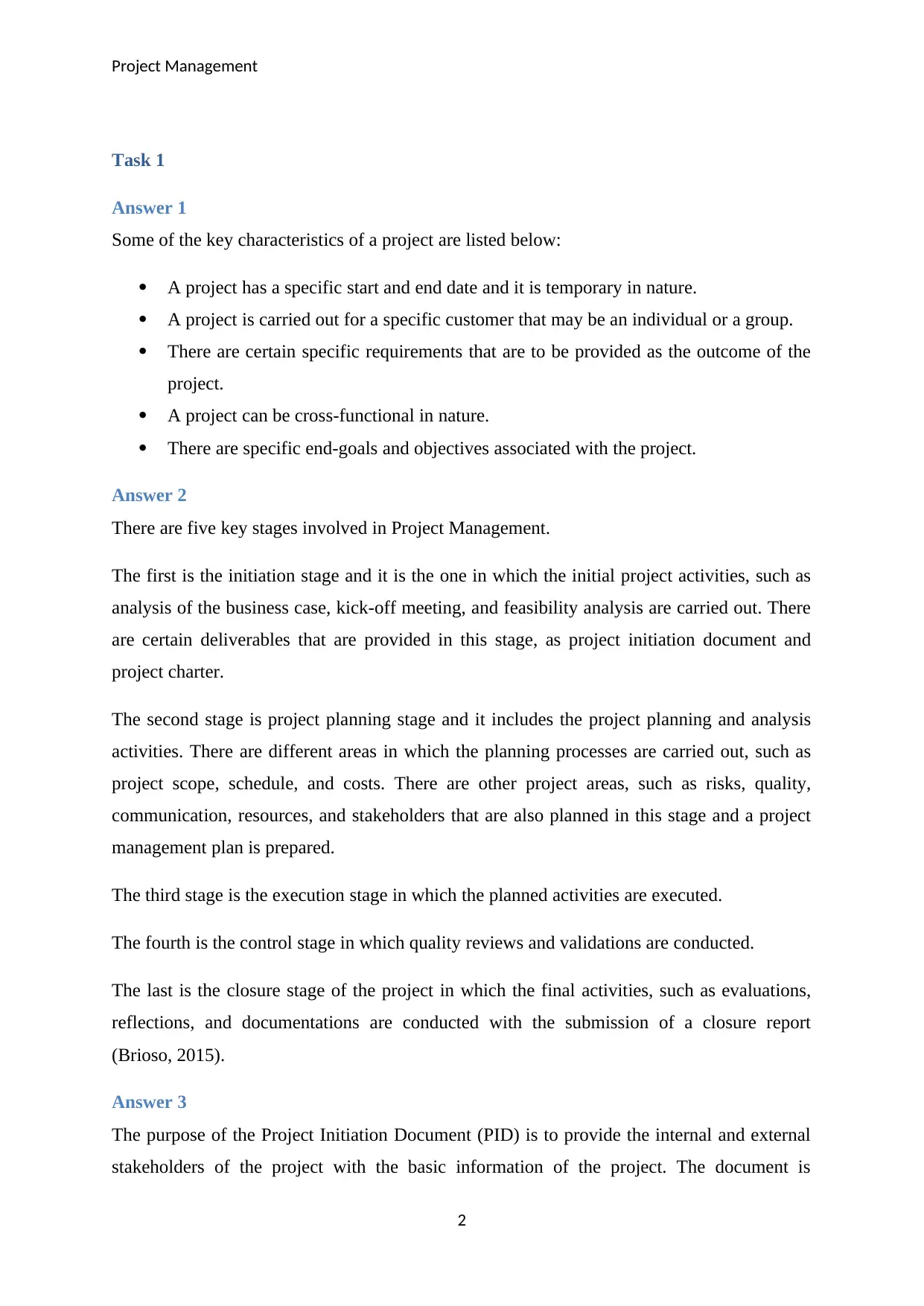
Project Management
Task 1
Answer 1
Some of the key characteristics of a project are listed below:
A project has a specific start and end date and it is temporary in nature.
A project is carried out for a specific customer that may be an individual or a group.
There are certain specific requirements that are to be provided as the outcome of the
project.
A project can be cross-functional in nature.
There are specific end-goals and objectives associated with the project.
Answer 2
There are five key stages involved in Project Management.
The first is the initiation stage and it is the one in which the initial project activities, such as
analysis of the business case, kick-off meeting, and feasibility analysis are carried out. There
are certain deliverables that are provided in this stage, as project initiation document and
project charter.
The second stage is project planning stage and it includes the project planning and analysis
activities. There are different areas in which the planning processes are carried out, such as
project scope, schedule, and costs. There are other project areas, such as risks, quality,
communication, resources, and stakeholders that are also planned in this stage and a project
management plan is prepared.
The third stage is the execution stage in which the planned activities are executed.
The fourth is the control stage in which quality reviews and validations are conducted.
The last is the closure stage of the project in which the final activities, such as evaluations,
reflections, and documentations are conducted with the submission of a closure report
(Brioso, 2015).
Answer 3
The purpose of the Project Initiation Document (PID) is to provide the internal and external
stakeholders of the project with the basic information of the project. The document is
2
Task 1
Answer 1
Some of the key characteristics of a project are listed below:
A project has a specific start and end date and it is temporary in nature.
A project is carried out for a specific customer that may be an individual or a group.
There are certain specific requirements that are to be provided as the outcome of the
project.
A project can be cross-functional in nature.
There are specific end-goals and objectives associated with the project.
Answer 2
There are five key stages involved in Project Management.
The first is the initiation stage and it is the one in which the initial project activities, such as
analysis of the business case, kick-off meeting, and feasibility analysis are carried out. There
are certain deliverables that are provided in this stage, as project initiation document and
project charter.
The second stage is project planning stage and it includes the project planning and analysis
activities. There are different areas in which the planning processes are carried out, such as
project scope, schedule, and costs. There are other project areas, such as risks, quality,
communication, resources, and stakeholders that are also planned in this stage and a project
management plan is prepared.
The third stage is the execution stage in which the planned activities are executed.
The fourth is the control stage in which quality reviews and validations are conducted.
The last is the closure stage of the project in which the final activities, such as evaluations,
reflections, and documentations are conducted with the submission of a closure report
(Brioso, 2015).
Answer 3
The purpose of the Project Initiation Document (PID) is to provide the internal and external
stakeholders of the project with the basic information of the project. The document is
2
⊘ This is a preview!⊘
Do you want full access?
Subscribe today to unlock all pages.

Trusted by 1+ million students worldwide
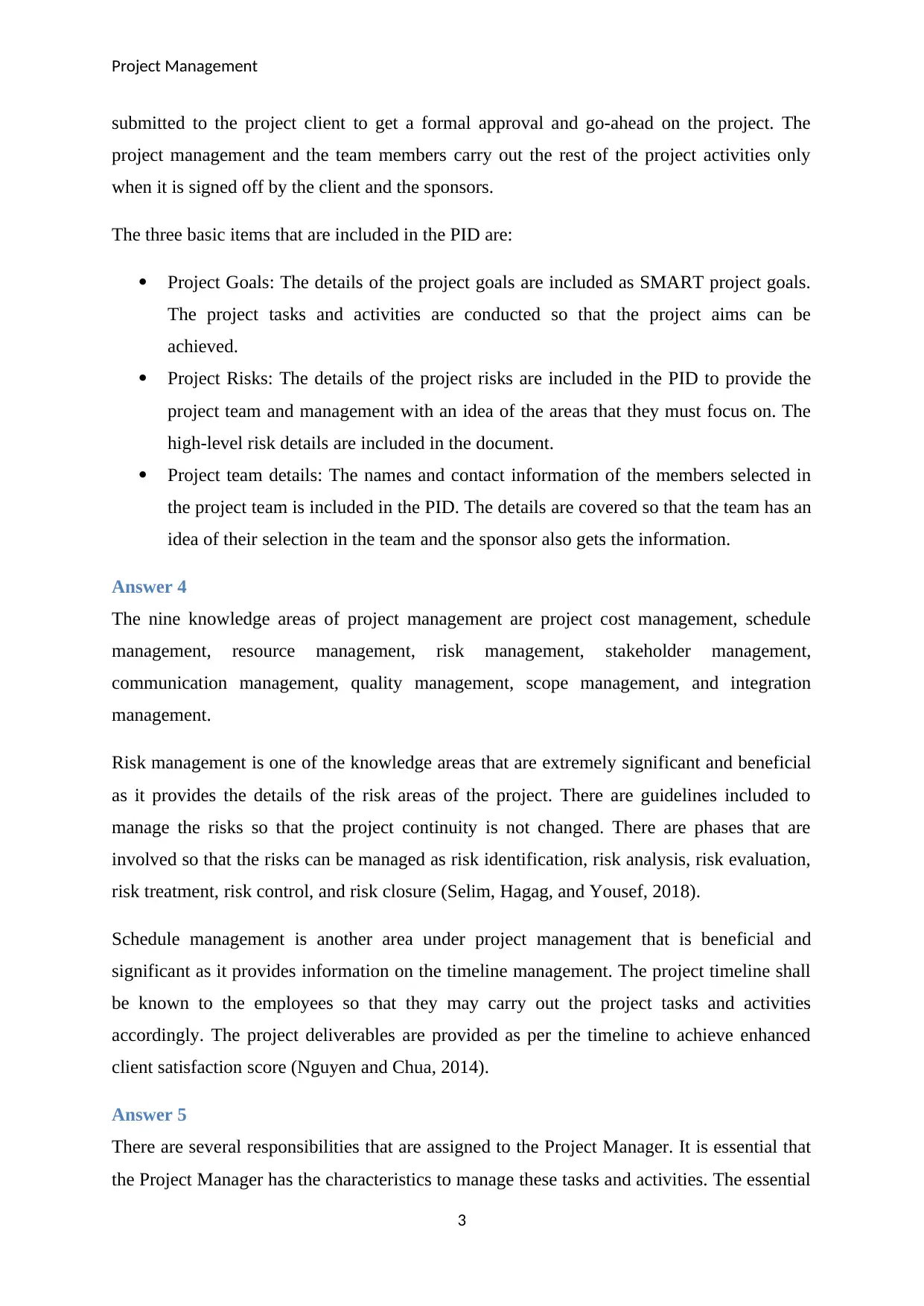
Project Management
submitted to the project client to get a formal approval and go-ahead on the project. The
project management and the team members carry out the rest of the project activities only
when it is signed off by the client and the sponsors.
The three basic items that are included in the PID are:
Project Goals: The details of the project goals are included as SMART project goals.
The project tasks and activities are conducted so that the project aims can be
achieved.
Project Risks: The details of the project risks are included in the PID to provide the
project team and management with an idea of the areas that they must focus on. The
high-level risk details are included in the document.
Project team details: The names and contact information of the members selected in
the project team is included in the PID. The details are covered so that the team has an
idea of their selection in the team and the sponsor also gets the information.
Answer 4
The nine knowledge areas of project management are project cost management, schedule
management, resource management, risk management, stakeholder management,
communication management, quality management, scope management, and integration
management.
Risk management is one of the knowledge areas that are extremely significant and beneficial
as it provides the details of the risk areas of the project. There are guidelines included to
manage the risks so that the project continuity is not changed. There are phases that are
involved so that the risks can be managed as risk identification, risk analysis, risk evaluation,
risk treatment, risk control, and risk closure (Selim, Hagag, and Yousef, 2018).
Schedule management is another area under project management that is beneficial and
significant as it provides information on the timeline management. The project timeline shall
be known to the employees so that they may carry out the project tasks and activities
accordingly. The project deliverables are provided as per the timeline to achieve enhanced
client satisfaction score (Nguyen and Chua, 2014).
Answer 5
There are several responsibilities that are assigned to the Project Manager. It is essential that
the Project Manager has the characteristics to manage these tasks and activities. The essential
3
submitted to the project client to get a formal approval and go-ahead on the project. The
project management and the team members carry out the rest of the project activities only
when it is signed off by the client and the sponsors.
The three basic items that are included in the PID are:
Project Goals: The details of the project goals are included as SMART project goals.
The project tasks and activities are conducted so that the project aims can be
achieved.
Project Risks: The details of the project risks are included in the PID to provide the
project team and management with an idea of the areas that they must focus on. The
high-level risk details are included in the document.
Project team details: The names and contact information of the members selected in
the project team is included in the PID. The details are covered so that the team has an
idea of their selection in the team and the sponsor also gets the information.
Answer 4
The nine knowledge areas of project management are project cost management, schedule
management, resource management, risk management, stakeholder management,
communication management, quality management, scope management, and integration
management.
Risk management is one of the knowledge areas that are extremely significant and beneficial
as it provides the details of the risk areas of the project. There are guidelines included to
manage the risks so that the project continuity is not changed. There are phases that are
involved so that the risks can be managed as risk identification, risk analysis, risk evaluation,
risk treatment, risk control, and risk closure (Selim, Hagag, and Yousef, 2018).
Schedule management is another area under project management that is beneficial and
significant as it provides information on the timeline management. The project timeline shall
be known to the employees so that they may carry out the project tasks and activities
accordingly. The project deliverables are provided as per the timeline to achieve enhanced
client satisfaction score (Nguyen and Chua, 2014).
Answer 5
There are several responsibilities that are assigned to the Project Manager. It is essential that
the Project Manager has the characteristics to manage these tasks and activities. The essential
3
Paraphrase This Document
Need a fresh take? Get an instant paraphrase of this document with our AI Paraphraser
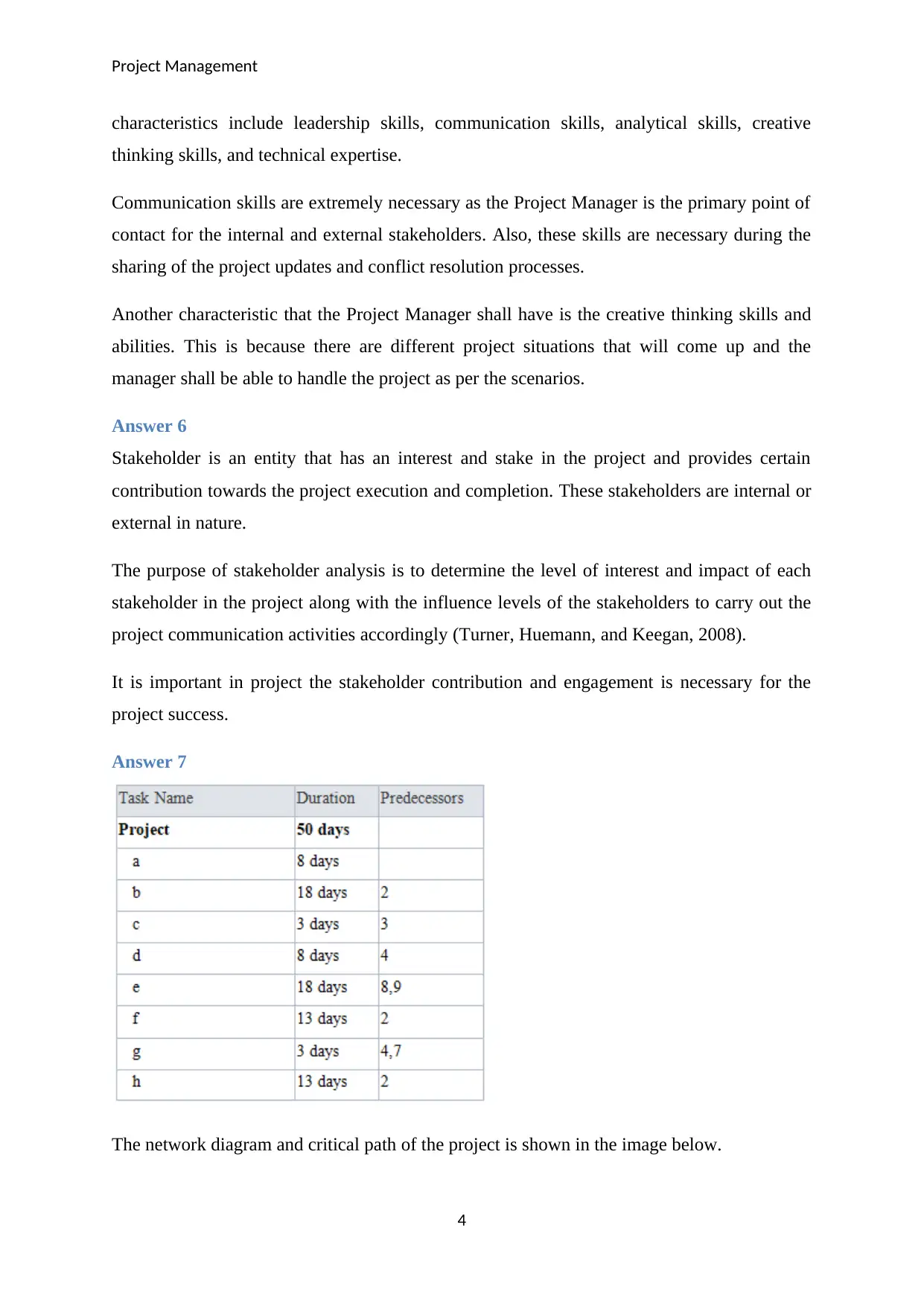
Project Management
characteristics include leadership skills, communication skills, analytical skills, creative
thinking skills, and technical expertise.
Communication skills are extremely necessary as the Project Manager is the primary point of
contact for the internal and external stakeholders. Also, these skills are necessary during the
sharing of the project updates and conflict resolution processes.
Another characteristic that the Project Manager shall have is the creative thinking skills and
abilities. This is because there are different project situations that will come up and the
manager shall be able to handle the project as per the scenarios.
Answer 6
Stakeholder is an entity that has an interest and stake in the project and provides certain
contribution towards the project execution and completion. These stakeholders are internal or
external in nature.
The purpose of stakeholder analysis is to determine the level of interest and impact of each
stakeholder in the project along with the influence levels of the stakeholders to carry out the
project communication activities accordingly (Turner, Huemann, and Keegan, 2008).
It is important in project the stakeholder contribution and engagement is necessary for the
project success.
Answer 7
The network diagram and critical path of the project is shown in the image below.
4
characteristics include leadership skills, communication skills, analytical skills, creative
thinking skills, and technical expertise.
Communication skills are extremely necessary as the Project Manager is the primary point of
contact for the internal and external stakeholders. Also, these skills are necessary during the
sharing of the project updates and conflict resolution processes.
Another characteristic that the Project Manager shall have is the creative thinking skills and
abilities. This is because there are different project situations that will come up and the
manager shall be able to handle the project as per the scenarios.
Answer 6
Stakeholder is an entity that has an interest and stake in the project and provides certain
contribution towards the project execution and completion. These stakeholders are internal or
external in nature.
The purpose of stakeholder analysis is to determine the level of interest and impact of each
stakeholder in the project along with the influence levels of the stakeholders to carry out the
project communication activities accordingly (Turner, Huemann, and Keegan, 2008).
It is important in project the stakeholder contribution and engagement is necessary for the
project success.
Answer 7
The network diagram and critical path of the project is shown in the image below.
4
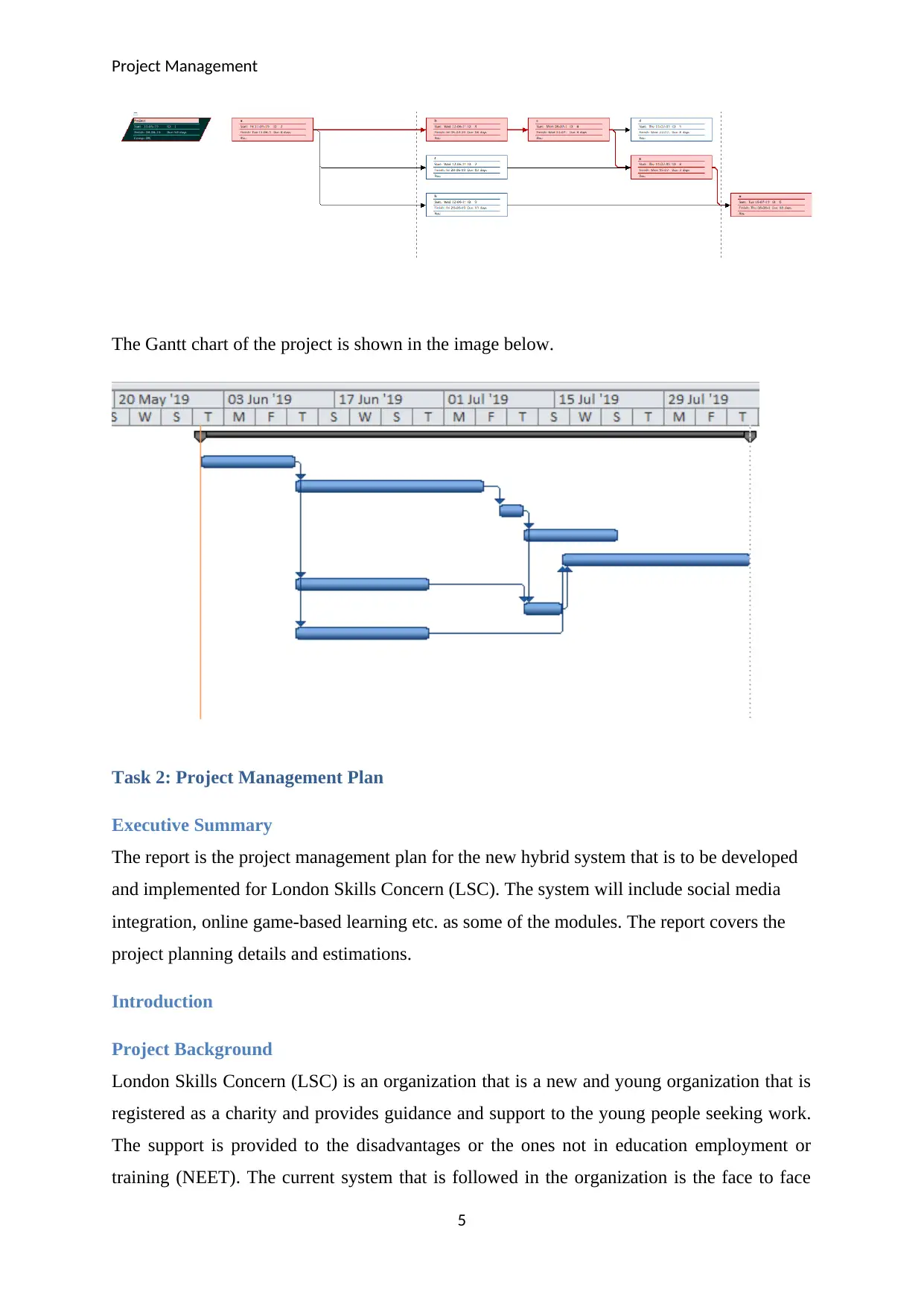
Project Management
The Gantt chart of the project is shown in the image below.
Task 2: Project Management Plan
Executive Summary
The report is the project management plan for the new hybrid system that is to be developed
and implemented for London Skills Concern (LSC). The system will include social media
integration, online game-based learning etc. as some of the modules. The report covers the
project planning details and estimations.
Introduction
Project Background
London Skills Concern (LSC) is an organization that is a new and young organization that is
registered as a charity and provides guidance and support to the young people seeking work.
The support is provided to the disadvantages or the ones not in education employment or
training (NEET). The current system that is followed in the organization is the face to face
5
The Gantt chart of the project is shown in the image below.
Task 2: Project Management Plan
Executive Summary
The report is the project management plan for the new hybrid system that is to be developed
and implemented for London Skills Concern (LSC). The system will include social media
integration, online game-based learning etc. as some of the modules. The report covers the
project planning details and estimations.
Introduction
Project Background
London Skills Concern (LSC) is an organization that is a new and young organization that is
registered as a charity and provides guidance and support to the young people seeking work.
The support is provided to the disadvantages or the ones not in education employment or
training (NEET). The current system that is followed in the organization is the face to face
5
⊘ This is a preview!⊘
Do you want full access?
Subscribe today to unlock all pages.

Trusted by 1+ million students worldwide
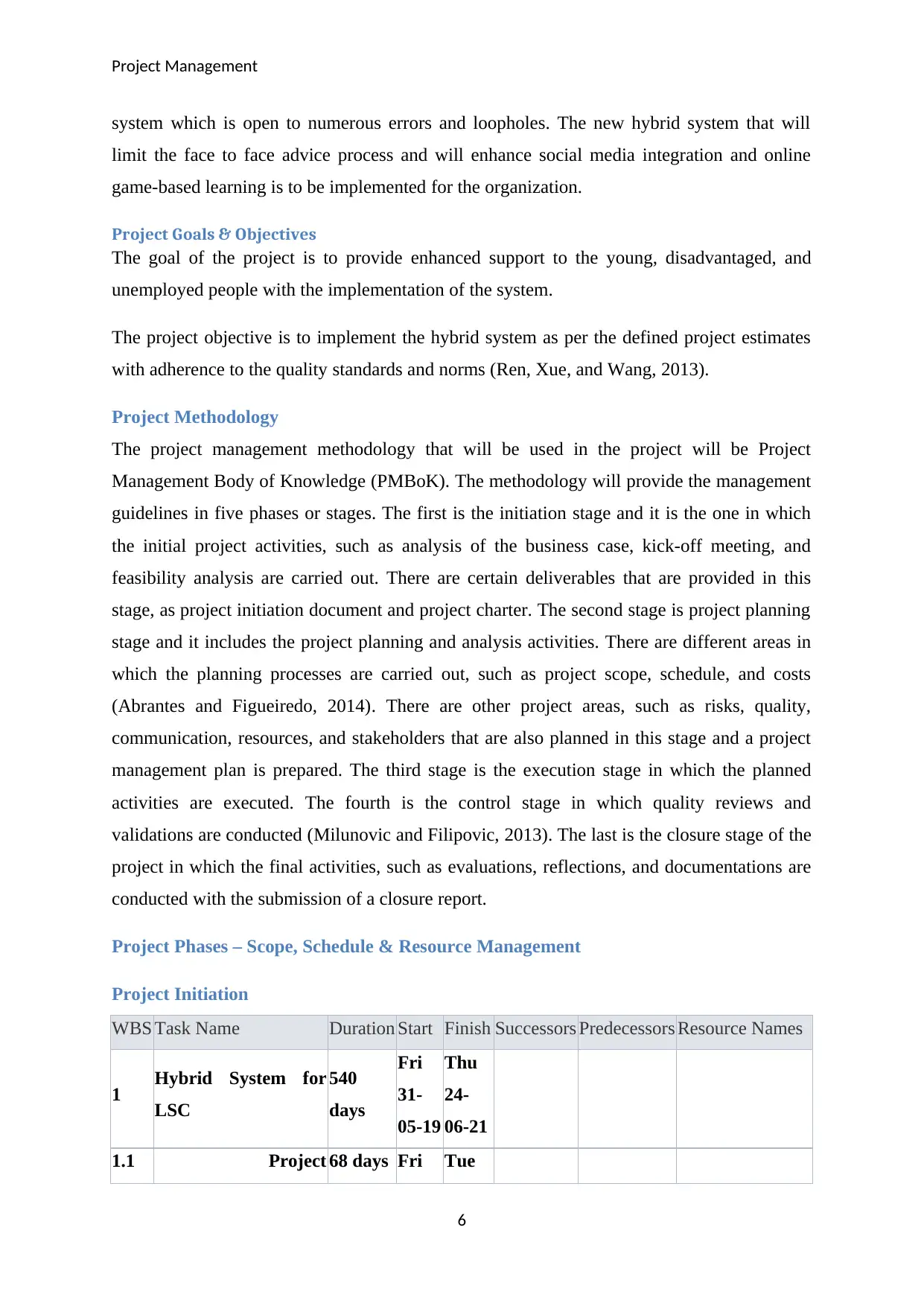
Project Management
system which is open to numerous errors and loopholes. The new hybrid system that will
limit the face to face advice process and will enhance social media integration and online
game-based learning is to be implemented for the organization.
Project Goals & Objectives
The goal of the project is to provide enhanced support to the young, disadvantaged, and
unemployed people with the implementation of the system.
The project objective is to implement the hybrid system as per the defined project estimates
with adherence to the quality standards and norms (Ren, Xue, and Wang, 2013).
Project Methodology
The project management methodology that will be used in the project will be Project
Management Body of Knowledge (PMBoK). The methodology will provide the management
guidelines in five phases or stages. The first is the initiation stage and it is the one in which
the initial project activities, such as analysis of the business case, kick-off meeting, and
feasibility analysis are carried out. There are certain deliverables that are provided in this
stage, as project initiation document and project charter. The second stage is project planning
stage and it includes the project planning and analysis activities. There are different areas in
which the planning processes are carried out, such as project scope, schedule, and costs
(Abrantes and Figueiredo, 2014). There are other project areas, such as risks, quality,
communication, resources, and stakeholders that are also planned in this stage and a project
management plan is prepared. The third stage is the execution stage in which the planned
activities are executed. The fourth is the control stage in which quality reviews and
validations are conducted (Milunovic and Filipovic, 2013). The last is the closure stage of the
project in which the final activities, such as evaluations, reflections, and documentations are
conducted with the submission of a closure report.
Project Phases – Scope, Schedule & Resource Management
Project Initiation
WBS Task Name Duration Start Finish Successors Predecessors Resource Names
1 Hybrid System for
LSC
540
days
Fri
31-
05-19
Thu
24-
06-21
1.1 Project 68 days Fri Tue
6
system which is open to numerous errors and loopholes. The new hybrid system that will
limit the face to face advice process and will enhance social media integration and online
game-based learning is to be implemented for the organization.
Project Goals & Objectives
The goal of the project is to provide enhanced support to the young, disadvantaged, and
unemployed people with the implementation of the system.
The project objective is to implement the hybrid system as per the defined project estimates
with adherence to the quality standards and norms (Ren, Xue, and Wang, 2013).
Project Methodology
The project management methodology that will be used in the project will be Project
Management Body of Knowledge (PMBoK). The methodology will provide the management
guidelines in five phases or stages. The first is the initiation stage and it is the one in which
the initial project activities, such as analysis of the business case, kick-off meeting, and
feasibility analysis are carried out. There are certain deliverables that are provided in this
stage, as project initiation document and project charter. The second stage is project planning
stage and it includes the project planning and analysis activities. There are different areas in
which the planning processes are carried out, such as project scope, schedule, and costs
(Abrantes and Figueiredo, 2014). There are other project areas, such as risks, quality,
communication, resources, and stakeholders that are also planned in this stage and a project
management plan is prepared. The third stage is the execution stage in which the planned
activities are executed. The fourth is the control stage in which quality reviews and
validations are conducted (Milunovic and Filipovic, 2013). The last is the closure stage of the
project in which the final activities, such as evaluations, reflections, and documentations are
conducted with the submission of a closure report.
Project Phases – Scope, Schedule & Resource Management
Project Initiation
WBS Task Name Duration Start Finish Successors Predecessors Resource Names
1 Hybrid System for
LSC
540
days
Fri
31-
05-19
Thu
24-
06-21
1.1 Project 68 days Fri Tue
6
Paraphrase This Document
Need a fresh take? Get an instant paraphrase of this document with our AI Paraphraser

Project Management
Management Stage
1: Initiation
31-
05-19
03-
09-19
1.1.1
Analysis of
existing LSC
operations and
business lines
11 days
Fri
31-
05-19
Fri
14-
06-19
4,5 Business Analyst
1.1.2 Listing of the gaps
identified 9 days
Mon
17-
06-19
Thu
27-
06-19
3 Business Analyst
1.1.3
Problems and
loopholes in face to
face method of advice
9 days
Mon
17-
06-19
Thu
27-
06-19
6 3 Project Manager
1.1.4
Proposal on the
projects that can be
undertaken
17 days
Fri
28-
06-19
Mon
22-
07-19
7 5 Project Manager
1.1.5
Weighted score
analysis - Selection of
hybrid system project
13 days
Tue
23-
07-19
Thu
08-
08-19
8 6 Business Analyst
1.1.6
High-level project
analysis and feasibility
studies
18 days
Fri
09-
08-19
Tue
03-
09-19
9,11,13 7
Business
Analyst ,Data
Analyst ,Project
Manager
1.1.7
Milestone 1:
Project Initiation
Document
0 days
Tue
03-
09-19
Tue
03-
09-19
8
Project Planning
1.2 Project Management
Stage 2: Planning 77 days
Wed
04-
09-19
Thu
19-
12-19
1.2.
1
Determination of
project modules - Data
21 days Wed
04-
Wed
02-
12 8 Application
Developer,
7
Management Stage
1: Initiation
31-
05-19
03-
09-19
1.1.1
Analysis of
existing LSC
operations and
business lines
11 days
Fri
31-
05-19
Fri
14-
06-19
4,5 Business Analyst
1.1.2 Listing of the gaps
identified 9 days
Mon
17-
06-19
Thu
27-
06-19
3 Business Analyst
1.1.3
Problems and
loopholes in face to
face method of advice
9 days
Mon
17-
06-19
Thu
27-
06-19
6 3 Project Manager
1.1.4
Proposal on the
projects that can be
undertaken
17 days
Fri
28-
06-19
Mon
22-
07-19
7 5 Project Manager
1.1.5
Weighted score
analysis - Selection of
hybrid system project
13 days
Tue
23-
07-19
Thu
08-
08-19
8 6 Business Analyst
1.1.6
High-level project
analysis and feasibility
studies
18 days
Fri
09-
08-19
Tue
03-
09-19
9,11,13 7
Business
Analyst ,Data
Analyst ,Project
Manager
1.1.7
Milestone 1:
Project Initiation
Document
0 days
Tue
03-
09-19
Tue
03-
09-19
8
Project Planning
1.2 Project Management
Stage 2: Planning 77 days
Wed
04-
09-19
Thu
19-
12-19
1.2.
1
Determination of
project modules - Data
21 days Wed
04-
Wed
02-
12 8 Application
Developer,
7
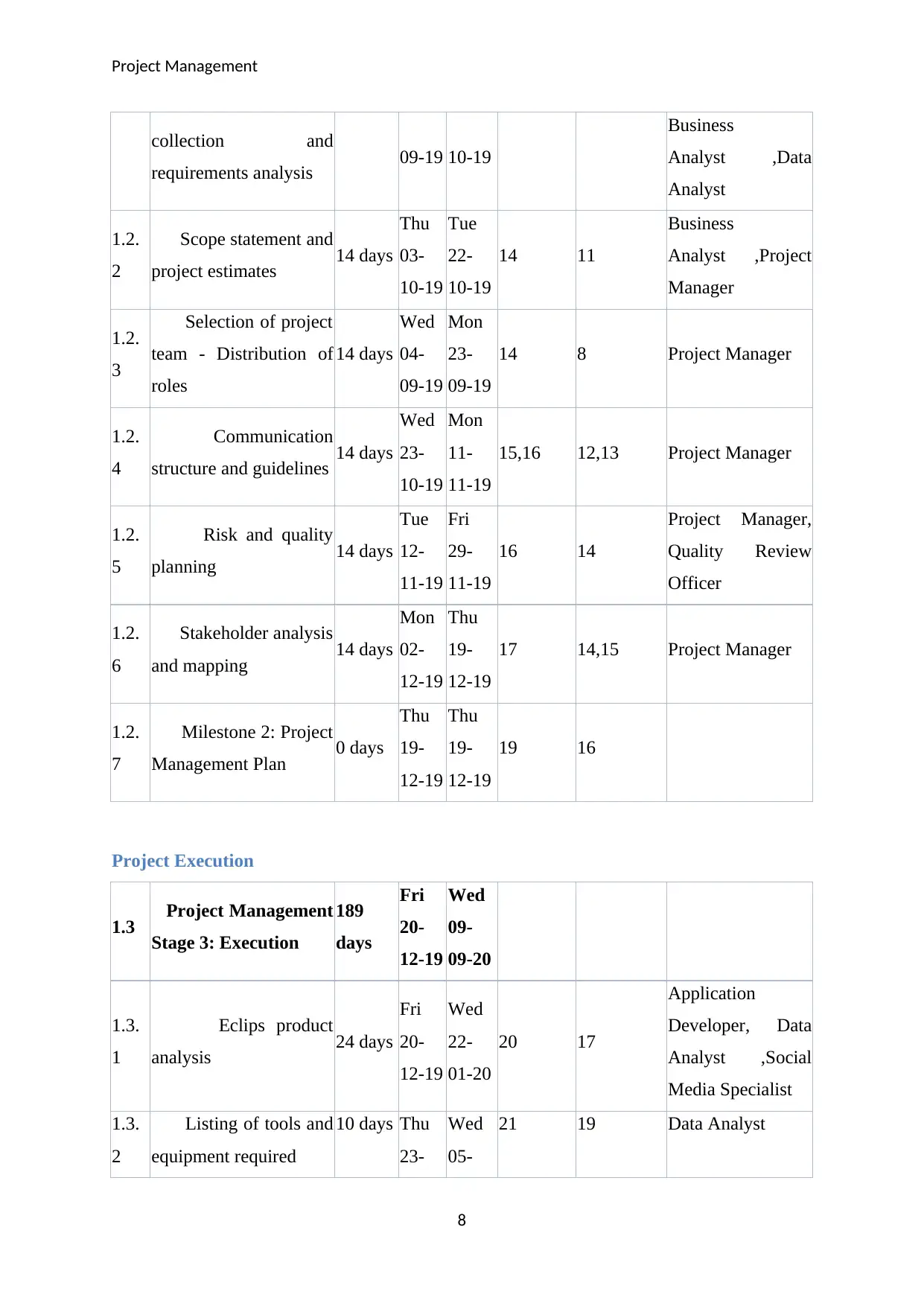
Project Management
collection and
requirements analysis 09-19 10-19
Business
Analyst ,Data
Analyst
1.2.
2
Scope statement and
project estimates 14 days
Thu
03-
10-19
Tue
22-
10-19
14 11
Business
Analyst ,Project
Manager
1.2.
3
Selection of project
team - Distribution of
roles
14 days
Wed
04-
09-19
Mon
23-
09-19
14 8 Project Manager
1.2.
4
Communication
structure and guidelines 14 days
Wed
23-
10-19
Mon
11-
11-19
15,16 12,13 Project Manager
1.2.
5
Risk and quality
planning 14 days
Tue
12-
11-19
Fri
29-
11-19
16 14
Project Manager,
Quality Review
Officer
1.2.
6
Stakeholder analysis
and mapping 14 days
Mon
02-
12-19
Thu
19-
12-19
17 14,15 Project Manager
1.2.
7
Milestone 2: Project
Management Plan 0 days
Thu
19-
12-19
Thu
19-
12-19
19 16
Project Execution
1.3 Project Management
Stage 3: Execution
189
days
Fri
20-
12-19
Wed
09-
09-20
1.3.
1
Eclips product
analysis 24 days
Fri
20-
12-19
Wed
22-
01-20
20 17
Application
Developer, Data
Analyst ,Social
Media Specialist
1.3.
2
Listing of tools and
equipment required
10 days Thu
23-
Wed
05-
21 19 Data Analyst
8
collection and
requirements analysis 09-19 10-19
Business
Analyst ,Data
Analyst
1.2.
2
Scope statement and
project estimates 14 days
Thu
03-
10-19
Tue
22-
10-19
14 11
Business
Analyst ,Project
Manager
1.2.
3
Selection of project
team - Distribution of
roles
14 days
Wed
04-
09-19
Mon
23-
09-19
14 8 Project Manager
1.2.
4
Communication
structure and guidelines 14 days
Wed
23-
10-19
Mon
11-
11-19
15,16 12,13 Project Manager
1.2.
5
Risk and quality
planning 14 days
Tue
12-
11-19
Fri
29-
11-19
16 14
Project Manager,
Quality Review
Officer
1.2.
6
Stakeholder analysis
and mapping 14 days
Mon
02-
12-19
Thu
19-
12-19
17 14,15 Project Manager
1.2.
7
Milestone 2: Project
Management Plan 0 days
Thu
19-
12-19
Thu
19-
12-19
19 16
Project Execution
1.3 Project Management
Stage 3: Execution
189
days
Fri
20-
12-19
Wed
09-
09-20
1.3.
1
Eclips product
analysis 24 days
Fri
20-
12-19
Wed
22-
01-20
20 17
Application
Developer, Data
Analyst ,Social
Media Specialist
1.3.
2
Listing of tools and
equipment required
10 days Thu
23-
Wed
05-
21 19 Data Analyst
8
⊘ This is a preview!⊘
Do you want full access?
Subscribe today to unlock all pages.

Trusted by 1+ million students worldwide
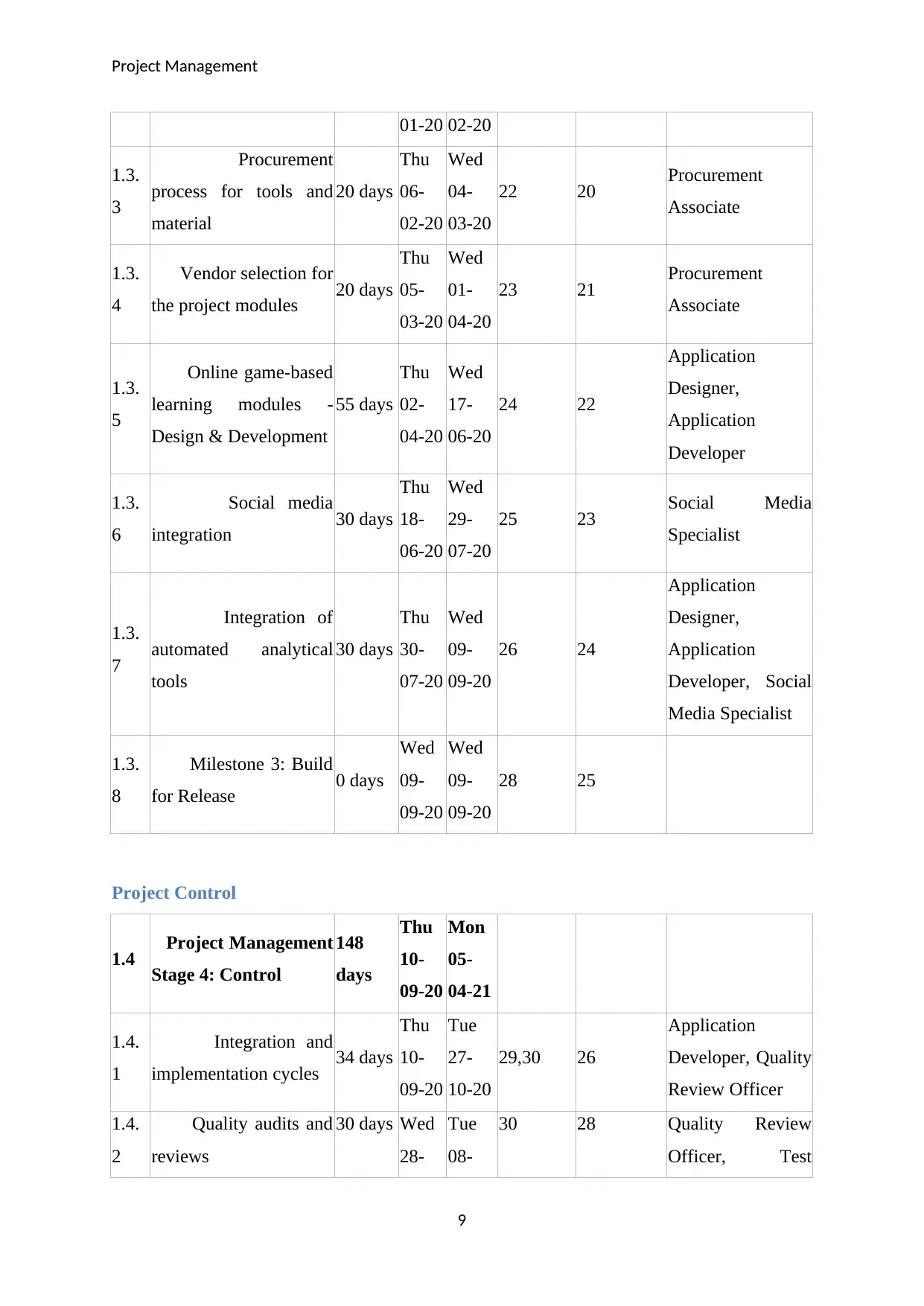
Project Management
01-20 02-20
1.3.
3
Procurement
process for tools and
material
20 days
Thu
06-
02-20
Wed
04-
03-20
22 20 Procurement
Associate
1.3.
4
Vendor selection for
the project modules 20 days
Thu
05-
03-20
Wed
01-
04-20
23 21 Procurement
Associate
1.3.
5
Online game-based
learning modules -
Design & Development
55 days
Thu
02-
04-20
Wed
17-
06-20
24 22
Application
Designer,
Application
Developer
1.3.
6
Social media
integration 30 days
Thu
18-
06-20
Wed
29-
07-20
25 23 Social Media
Specialist
1.3.
7
Integration of
automated analytical
tools
30 days
Thu
30-
07-20
Wed
09-
09-20
26 24
Application
Designer,
Application
Developer, Social
Media Specialist
1.3.
8
Milestone 3: Build
for Release 0 days
Wed
09-
09-20
Wed
09-
09-20
28 25
Project Control
1.4 Project Management
Stage 4: Control
148
days
Thu
10-
09-20
Mon
05-
04-21
1.4.
1
Integration and
implementation cycles 34 days
Thu
10-
09-20
Tue
27-
10-20
29,30 26
Application
Developer, Quality
Review Officer
1.4.
2
Quality audits and
reviews
30 days Wed
28-
Tue
08-
30 28 Quality Review
Officer, Test
9
01-20 02-20
1.3.
3
Procurement
process for tools and
material
20 days
Thu
06-
02-20
Wed
04-
03-20
22 20 Procurement
Associate
1.3.
4
Vendor selection for
the project modules 20 days
Thu
05-
03-20
Wed
01-
04-20
23 21 Procurement
Associate
1.3.
5
Online game-based
learning modules -
Design & Development
55 days
Thu
02-
04-20
Wed
17-
06-20
24 22
Application
Designer,
Application
Developer
1.3.
6
Social media
integration 30 days
Thu
18-
06-20
Wed
29-
07-20
25 23 Social Media
Specialist
1.3.
7
Integration of
automated analytical
tools
30 days
Thu
30-
07-20
Wed
09-
09-20
26 24
Application
Designer,
Application
Developer, Social
Media Specialist
1.3.
8
Milestone 3: Build
for Release 0 days
Wed
09-
09-20
Wed
09-
09-20
28 25
Project Control
1.4 Project Management
Stage 4: Control
148
days
Thu
10-
09-20
Mon
05-
04-21
1.4.
1
Integration and
implementation cycles 34 days
Thu
10-
09-20
Tue
27-
10-20
29,30 26
Application
Developer, Quality
Review Officer
1.4.
2
Quality audits and
reviews
30 days Wed
28-
Tue
08-
30 28 Quality Review
Officer, Test
9
Paraphrase This Document
Need a fresh take? Get an instant paraphrase of this document with our AI Paraphraser
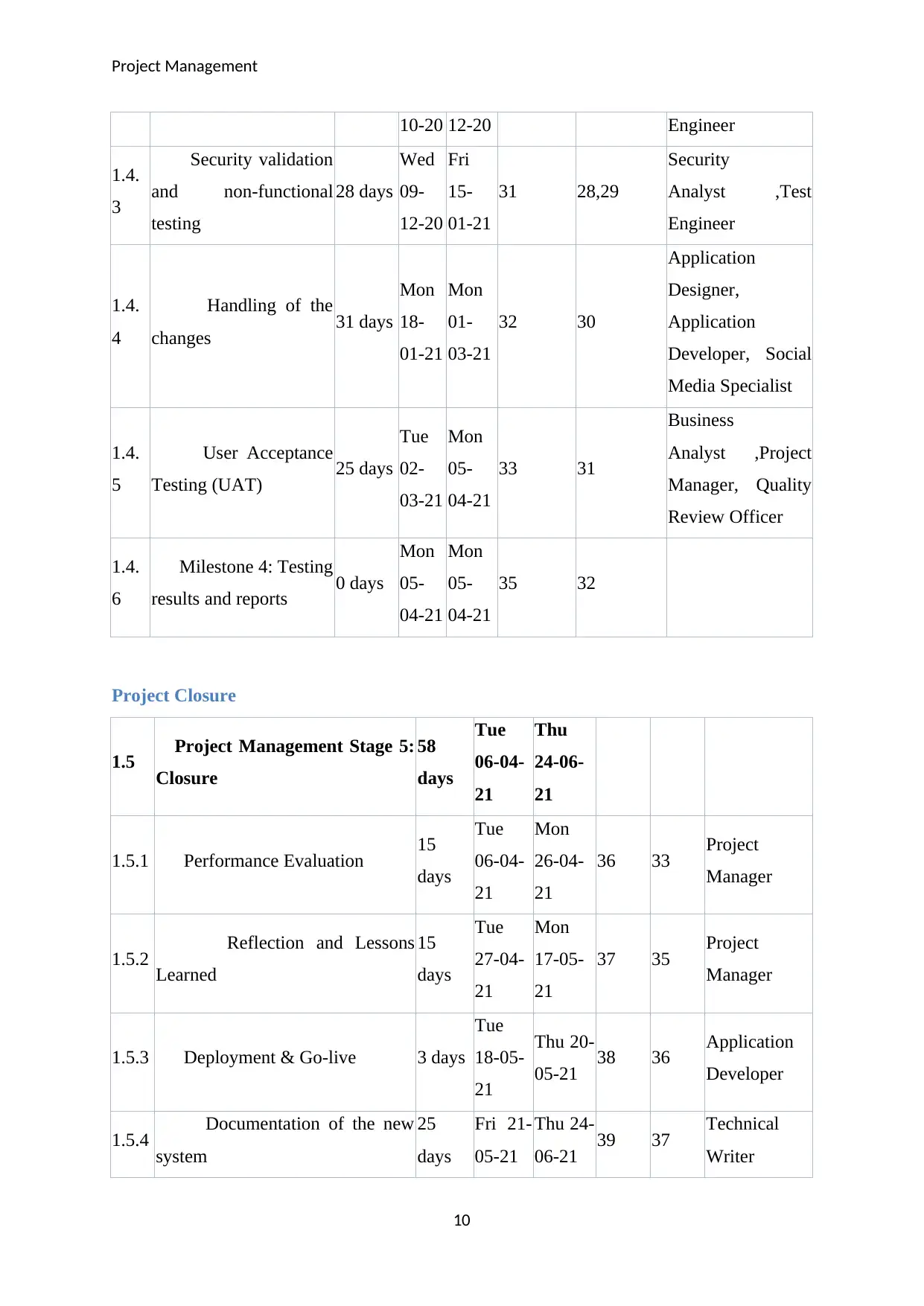
Project Management
10-20 12-20 Engineer
1.4.
3
Security validation
and non-functional
testing
28 days
Wed
09-
12-20
Fri
15-
01-21
31 28,29
Security
Analyst ,Test
Engineer
1.4.
4
Handling of the
changes 31 days
Mon
18-
01-21
Mon
01-
03-21
32 30
Application
Designer,
Application
Developer, Social
Media Specialist
1.4.
5
User Acceptance
Testing (UAT) 25 days
Tue
02-
03-21
Mon
05-
04-21
33 31
Business
Analyst ,Project
Manager, Quality
Review Officer
1.4.
6
Milestone 4: Testing
results and reports 0 days
Mon
05-
04-21
Mon
05-
04-21
35 32
Project Closure
1.5 Project Management Stage 5:
Closure
58
days
Tue
06-04-
21
Thu
24-06-
21
1.5.1 Performance Evaluation 15
days
Tue
06-04-
21
Mon
26-04-
21
36 33 Project
Manager
1.5.2 Reflection and Lessons
Learned
15
days
Tue
27-04-
21
Mon
17-05-
21
37 35 Project
Manager
1.5.3 Deployment & Go-live 3 days
Tue
18-05-
21
Thu 20-
05-21 38 36 Application
Developer
1.5.4 Documentation of the new
system
25
days
Fri 21-
05-21
Thu 24-
06-21 39 37 Technical
Writer
10
10-20 12-20 Engineer
1.4.
3
Security validation
and non-functional
testing
28 days
Wed
09-
12-20
Fri
15-
01-21
31 28,29
Security
Analyst ,Test
Engineer
1.4.
4
Handling of the
changes 31 days
Mon
18-
01-21
Mon
01-
03-21
32 30
Application
Designer,
Application
Developer, Social
Media Specialist
1.4.
5
User Acceptance
Testing (UAT) 25 days
Tue
02-
03-21
Mon
05-
04-21
33 31
Business
Analyst ,Project
Manager, Quality
Review Officer
1.4.
6
Milestone 4: Testing
results and reports 0 days
Mon
05-
04-21
Mon
05-
04-21
35 32
Project Closure
1.5 Project Management Stage 5:
Closure
58
days
Tue
06-04-
21
Thu
24-06-
21
1.5.1 Performance Evaluation 15
days
Tue
06-04-
21
Mon
26-04-
21
36 33 Project
Manager
1.5.2 Reflection and Lessons
Learned
15
days
Tue
27-04-
21
Mon
17-05-
21
37 35 Project
Manager
1.5.3 Deployment & Go-live 3 days
Tue
18-05-
21
Thu 20-
05-21 38 36 Application
Developer
1.5.4 Documentation of the new
system
25
days
Fri 21-
05-21
Thu 24-
06-21 39 37 Technical
Writer
10

Project Management
1.5.5 Milestone 5: Project Closure
Report 0 days
Thu
24-06-
21
Thu 24-
06-21 38
Project Budget
The use of bottom-up estimation technique is done to determine the budget (Sequeira and
Lopes, 2015).
WBS Task Name Duration Start Finish Successors Predecessors Resource
Names Cost
1 Hybrid System
for LSC
540
days
Fri
31-
05-
19
Thu
24-
06-21
£581,688.00
1.1
Project
Management
Stage 1:
Initiation
68 days
Fri
31-
05-
19
Tue
03-
09-19
£68,840.00
1.1.1
Analysis of
existing LSC
operations and
business lines
11 days
Fri
31-
05-
19
Fri
14-
06-19
4,5 Business
Analyst £6,600.00
1.1.2
Listing of
the gaps
identified
9 days
Mon
17-
06-
19
Thu
27-
06-19
3 Business
Analyst £5,400.00
1.1.3
Problems
and loopholes
in face to face
method of
advice
9 days
Mon
17-
06-
19
Thu
27-
06-19
6 3 Project
Manager £5,760.00
1.1.4 Proposal on
the projects that
17 days Fri
28-
Mon
22-
7 5 Project
Manager
£10,880.00
11
1.5.5 Milestone 5: Project Closure
Report 0 days
Thu
24-06-
21
Thu 24-
06-21 38
Project Budget
The use of bottom-up estimation technique is done to determine the budget (Sequeira and
Lopes, 2015).
WBS Task Name Duration Start Finish Successors Predecessors Resource
Names Cost
1 Hybrid System
for LSC
540
days
Fri
31-
05-
19
Thu
24-
06-21
£581,688.00
1.1
Project
Management
Stage 1:
Initiation
68 days
Fri
31-
05-
19
Tue
03-
09-19
£68,840.00
1.1.1
Analysis of
existing LSC
operations and
business lines
11 days
Fri
31-
05-
19
Fri
14-
06-19
4,5 Business
Analyst £6,600.00
1.1.2
Listing of
the gaps
identified
9 days
Mon
17-
06-
19
Thu
27-
06-19
3 Business
Analyst £5,400.00
1.1.3
Problems
and loopholes
in face to face
method of
advice
9 days
Mon
17-
06-
19
Thu
27-
06-19
6 3 Project
Manager £5,760.00
1.1.4 Proposal on
the projects that
17 days Fri
28-
Mon
22-
7 5 Project
Manager
£10,880.00
11
⊘ This is a preview!⊘
Do you want full access?
Subscribe today to unlock all pages.

Trusted by 1+ million students worldwide
1 out of 20
Related Documents
Your All-in-One AI-Powered Toolkit for Academic Success.
+13062052269
info@desklib.com
Available 24*7 on WhatsApp / Email
![[object Object]](/_next/static/media/star-bottom.7253800d.svg)
Unlock your academic potential
Copyright © 2020–2025 A2Z Services. All Rights Reserved. Developed and managed by ZUCOL.





